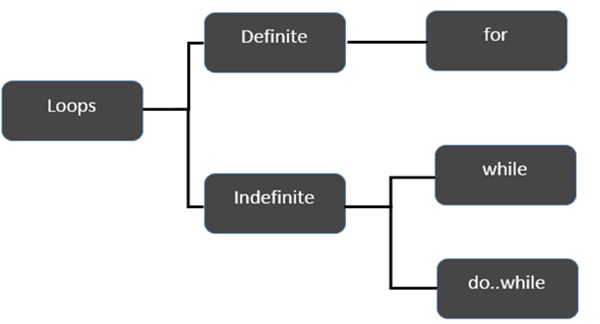Theoretical Paper
- Computer Organization
- Data Structure
- Digital Electronics
- Object Oriented Programming
- Discrete Mathematics
- Graph Theory
- Operating Systems
- Software Engineering
- Computer Graphics
- Database Management System
- Operation Research
- Computer Networking
- Image Processing
- Internet Technologies
- Micro Processor
- E-Commerce & ERP
- Dart Programming
Practical Paper
Industrial Training
Dart Programming - Loops
At times, certain instructions require repeated execution. Loops are an ideal way to do the same. A loop represents a set of instructions that must be repeated. In a loop’s context, a repetition is termed as an iteration.
The following figure illustrates the classification of loops −

Let’s start the discussion with Definite Loops. A loop whose number of iterations are definite/fixed is termed as a definite loop.
| Sr.No | Loop & Description |
| 1 | for loop |
| 2 | for…in Loop |
Moving on, let’s now discuss the indefinite loops. An indefinite loop is used when the number of iterations in a loop is indeterminate or unknown. Indefinite loops can be implemented using −
| Sr.No | Loop & Description |
| 1 | while Loop |
| 2 | do…while Loop |
Let us now move on and discuss the Loop Control Statements of Dart.
| Sr.No | Control Statement & Description |
| 1 | break Statement |
| 2 | continue Statement |
Using Labels to Control the Flow
A label is simply an identifier followed by a colon (:) that is applied to a statement or a block of code. A label can be used with break and continue to control the flow more precisely.
Line breaks are not allowed between the ‘continue’ or ‘break’ statement and its label name. Also, there should not be any other statement in between a label name and an associated loop.
Example: Label with Break
oid main() {
outerloop: // This is the label name
for (var i = 0; i < 5; i++) {
print("Innerloop: ${i}");
innerloop:
for (var j = 0; j < 5; j++) {
if (j > 3 ) break ;
// Quit the innermost loop
if (i == 2) break innerloop;
// Do the same thing
if (i == 4) break outerloop;
// Quit the outer loop
print("Innerloop: ${j}");
}
}
}
The following output is displayed on successful execution of the above code.
Innerloop: 0 Innerloop: 0 Innerloop: 1 Innerloop: 2 Innerloop: 3 Innerloop: 1 Innerloop: 0 Innerloop: 1 Innerloop: 2 Innerloop: 3 Innerloop: 2 Innerloop: 3 Innerloop: 0 Innerloop: 1 Innerloop: 2 Innerloop: 3 Innerloop: 4
Example: Label with continue
void main() {
outerloop: // This is the label name
for (var i = 0; i < 3; i++) {
print("Outerloop:${i}");
for (var j = 0; j < 5; j++) {
if (j == 3){
continue outerloop;
}
print("Innerloop:${j}");
}
}
}
The following output is displayed on successful execution of the above code.
Outerloop: 0 Innerloop: 0 Innerloop: 1 Innerloop: 2 Outerloop: 1 Innerloop: 0 Innerloop: 1 Innerloop: 2 Outerloop: 2 Innerloop: 0 Innerloop: 1 Innerloop: 2

